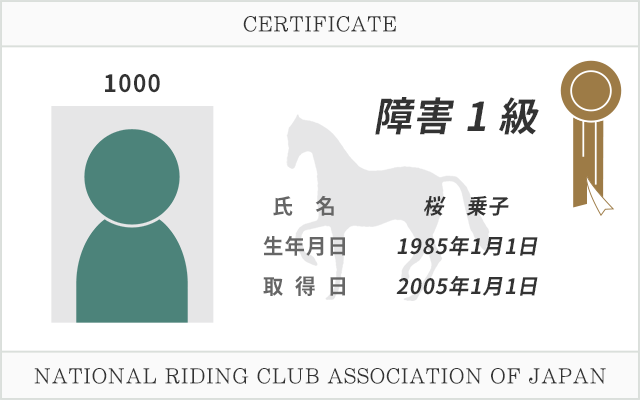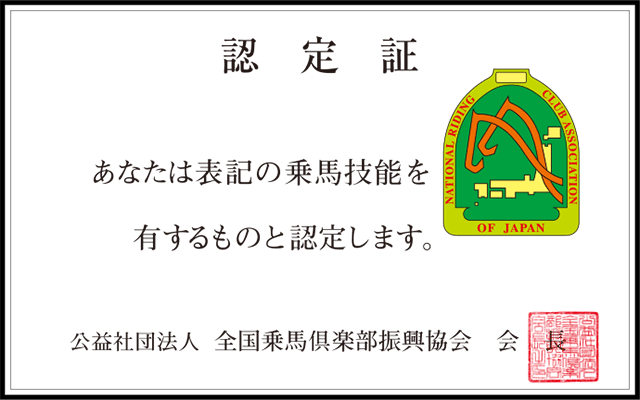Skill Certifications
Skill Certification Evaluations
Take on the challenge of getting your horseback riding skills certified!
Horseback riding skill certifications serve to certify one’s own skills based on certifications set up by National Riding Club Association of Japan (a public interest incorporated association) and which are uniform across Japan. Certifications can be obtained at a member club of the NRCA (there are also cases where horseback riding clubs who are NRCA members do this on a joint basis at big competitions).
Objective of Horseback Riding Skill Certifications
The objective of skills certifications is to have people who enjoy horseback riding to recognize the level of their own skills (skill levels are uniform across Japan), and to provide such people with help in setting goals suited to their respective skill levels.
The dates of evaluations conducted for skills certification differs depending on the club administering the exam. Please contact your club directly for more details. (Exams can be taken at most of member clubs).
What is more, individuals passing their exams are provided with certification cards for each level they pass.


Procedures
The examination fee is 10,800 yen (with tax) for all levels. However, please inquire at the club where your exam is to be held with respect to costs for borrowing horses, facility usage and so on.
Horseback Riding Skill Certification Mechanisms
British
-
 Level 5
Level 5
Practical Exam
(Group horseback riding)- An exam is conducted in a group horseback riding.
- The individual is able to mount and dismount the horse.
- The individual is able to ensure proper posturing while stopping and walking.
- The individual is able to do a posting trot with a lead pony on a small area of arena.
- The individual is able to perform opening inward the reins.
Written Exam [Examples]
- Name of horse body parts.
- Horse care.
- Handling and other elements involved in horseback riding.
-
 Level 4
Level 4
Practical Exam
(Group horseback riding)- An exam is conducted in a group horseback riding.
- Volte while walking and conduct turning movements (including half volte). Change direction by 90 degrees and change the diagonal while trotting.
- The individual is for the most part able to smoothly conduct the following sequence: stop, walk, trot, walk and stop.
- The individual is able to understand posting trot diagonals.
- The individual is able to maintain correct posturing during trotting exercises. The individual is able to, for the most, maneuver the reins and their legs. The individual is able to start and maintain a canter.
Written Exam [Examples]
- Equine coat colors. (chestnut, bay, grey, etc.)
- Name of horse body parts.
- Name of horseback riding gear pieces.
- First step commands.
- How the horse moves etc.
-
 Level 3
Level 3
Practical Exam - Start and maintain a canter (including the exercises from levels 4 and 5). The individual is able to, for the most part, increase and decrease walking speed. The individual is able to do voltes and half voltes.
- The individual is able to understand canter diagonals. The individual is able to change the diagonal at walk and trot.Suitability of assistance maneuvers.
- Pass through ground crossbars.
Written Exam - Names of hoof parts, graphics showing track exercises alongside the items from British Level 4 and Level 5 etc.
Obstacles
-
 Obstacles Level 3
Obstacles Level 3
Practical Exam - Around 6-8 obstacles. Combinations of obstacles do not need to be included. Course with at least two obstacles set up which are around 90 cm tall.
- Graded according to Criteria A. (Disobedience 3 times results in forfeiture) etc.
Written Exam - Exam questions from “Let’s Enjoy Riding”. (Issued by the NRCA)
- Question from the JEF Competition Rules.
Other - Individuals must have British Level 3 skill certification in order to take this exam.
-
 Obstacles Level 2
Obstacles Level 2
Practical Exam - Course with around 8-10 obstacles, which includes double in-and-out, and wherein there is at least one obstacle around 110 cm tall set up.
- Graded according to Criteria A. (Disobedience 3 times results in forfeiture)
Written Exam - Exam questions from “Let’s Enjoy Riding”. (Issued by the NRCA)
- Question from the JEF Competition Rules.
Other - Individuals must have Obstacles Level 3 skill certification in order to take this exam.
-
 Obstacles Level 1
Obstacles Level 1
Practical Exam - Course with around 8-10 obstacles, which includes double obstacles, and wherein at least 70% of the obstacles are around 110 cm tall.
- Graded according to Criteria A. (Disobedience 3 times results in forfeiture; no time deductions added)
Written Exam - Exam questions from “Let’s Enjoy Riding”. (Issued by the NRCA)
- Question from the JEF Competition Rules.
Other - Individuals must have Obstacles Level 2 skill certification in order to take this exam.
Riding Ground
-
 Riding Ground Level 2
Riding Ground Level 2
Practical Exam - Riding Ground Equestrian Event A2 Course. (Established by the Japan Equestrian Federation) [Evaluation in 2013]
- Graded according to Criteria A. (Disobedience 3 times results in forfeiture) etc.
Written Exam - Exam questions from “Let’s Enjoy Riding”. (Issued by the NRCA)
- Question from the JEF Competition Rules.
Other - Individuals must have British Level 3 skill certification in order to take this exam.
-
 Riding Ground Level 1
Riding Ground Level 1
Practical Exam - Riding Ground Equestrian Event A3 Course. (Established by the Japan Equestrian Federation) [Evaluation in 2013]
Written Exam - Exam questions from “Let’s Enjoy Riding”. (Issued by the NRCA)
- Question from the JEF Competition Rules.
Other - Individuals must have Riding Ground Level 2 skill certification in order to take this exam.
Endurance
-
 Endurance Level 3
Endurance Level 3
Practical Exam - Completion of a 20 KM trail ride.
Written Exam - Competition Rules. (From the JEF Competition Rules)
- Horse health management etc.
Other - Individuals must have British Level 3 or Western Level 3 skill certification in order to take this exam.
-
 Endurance Level 2
Endurance Level 2
Practical Exam - Completion of a 40 KM trail ride.
Written Exam - Competition Rules. (From the JEF Competition Rules)
- Basic veterinary medicine.
- Horse health management etc.
Other - Individuals must have Endurance Level 3 skill certification in order to take this exam.
-
 Endurance Level 1
Endurance Level 1
Practical Exam - Complete a course 80 KM or longer at an endurance event inside or outside Japan on three occasions.
(The individual will be deemed to have passed upon presenting the certificate of completion issued by the host of the event in question)
Written Exam - There is no written exam.
Other - Individuals must have Endurance Level 2 skill certification in order to take this exam.
- Complete a course 80 KM or longer at an endurance event inside or outside Japan on three occasions.
Western
-
 Western Level 5
Western Level 5
Practical Exam (Group horseback riding) - An exam is conducted in a group horseback riding.
- The individual is able to mount and dismount the horse.
- The individual is able to stop and walk.
- The individual is able to trot.
- The individual is able to maneuver with open reins.
- Two hands are OK regardless of the bit being used.
- Rein tying OK.
- Leading horse for group exercise OK.
Written Exam Exam questions are provided based on materials such as “LET'S ENJOY RIDING WESTERN”.
[Examples]
- Name of horse body parts.
- Horse care.
- Handling involved in horseback riding.
- Exercise orders used in Western level 5.
-
 Western Level 4
Western Level 4
Practical Exam (Group horseback riding) - An exam is conducted in a group horseback riding.
- The individual is able to change directions on the spot.
- The individual is able to change directions while walking and trotting.
- The individual is able to, for the most part, transition through the modes of horse movement up to the trot.
- The individual is able to start and maintain a canter (with rope).
- Two hands are OK regardless of the bit being used.
- Rein tying OK.
- Group exercise leading horse OK.
Written Exam Exam questions are provided based on materials such as “LET'S ENJOY RIDING WESTERN”.
[Examples]
- Equine coat colors.
- Names of horse body parts and horseback riding gear pieces.
- Exercise orders used in Western Level 4.
-
 Western Level 3
Western Level 3
Practical Exam - The individual is able to start and maintain a canter (with rope).
- The individual is able to understand the diagonal (lead) of the canter (with rope).
- The individual is able to smoothly transition through gaites of horse movement up to the canter.
- The individual is able to back up.
- The individual is able to go through one log while walking or trotting.
- Two hands are OK regardless of the bit being used.
- Rein tying not OK.
Written Exam Exam questions are provided based on materials such as “LET'S ENJOY RIDING WESTERN”.
- Equine coat colors.
- How horses move.
- Name of hoof parts.
- Exercise terminology used in Western Level 3.
- Western competition events.
-
 Western Level 2
Western Level 2
Practical Exam - The individual is able to, for the most part, speed up and slow down a canter (with rope).
- The individual is able to conduct a simple lead change.
- The individual is able to do a rollback.
- Whether or not the suitability and balance of assistance maneuvers is being maintained.
- Simple lead change using a stock sheet medal pattern.
- Two hands are OK regardless of the bit being used.
- Redos are allowed for up to a maximum of two pathway violations. There are no point deductions. However, a third violation will result in a score of zero.
- Rein tying not OK.
Written Exam Exam questions from “LET'S ENJOY RIDING WESTERN”. Competition rules from the booklet provided for questions.
- Exercise terminology used in Western Level 2.
- Mental readiness when it comes to riding a horse.
- Competition rules.
Other - Individuals must have Western Level 3 skill certification in order to take this exam.
-
 Western Level 1
Western Level 1
Practical Exam - Lead changes can be done in either a flying or simple fashion.
- Suitability and balance of assistance maneuvers.
- Redos are allowed for up to a maximum of two pathway violations. There are no point deductions. However, a third violation will result in a score of zero.
- Rein tying not OK.
Written Exam Exam questions from “LET'S ENJOY RIDING WESTERN”. Competition rules from the booklet provided for questions.
- Competition rules.
- Grading methods.
- Score of zero and no scores.
Other - Individuals must have Western Level 2 skill certification in order to take this exam.

